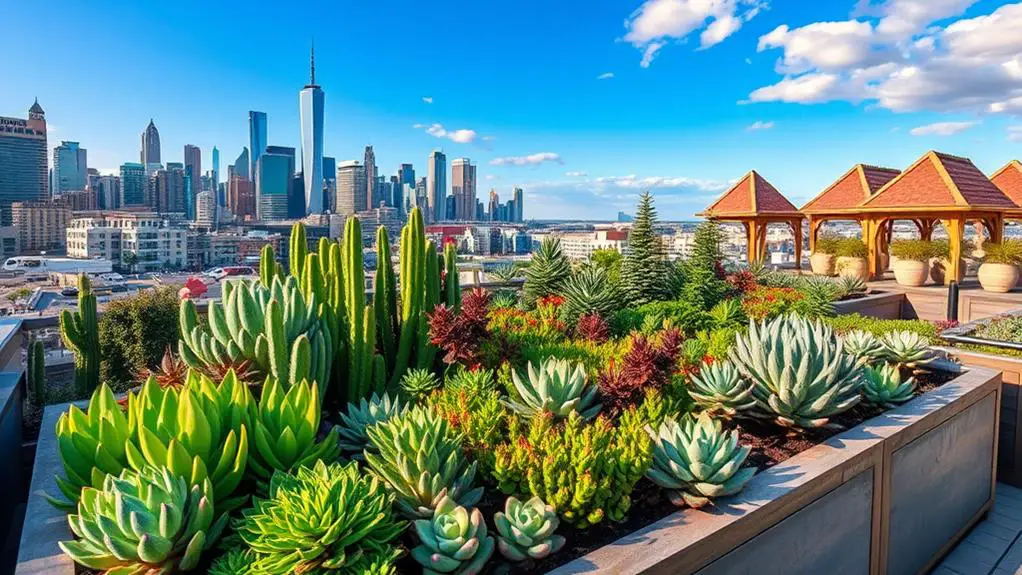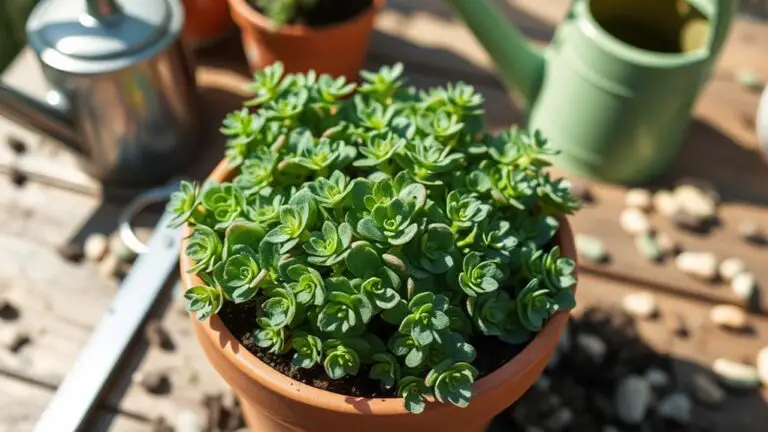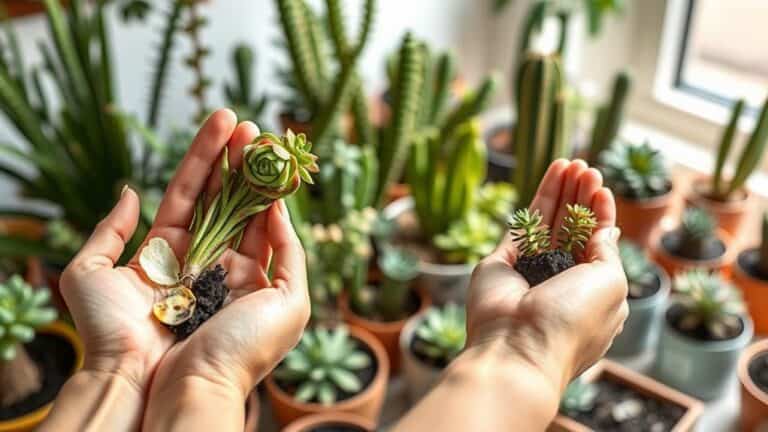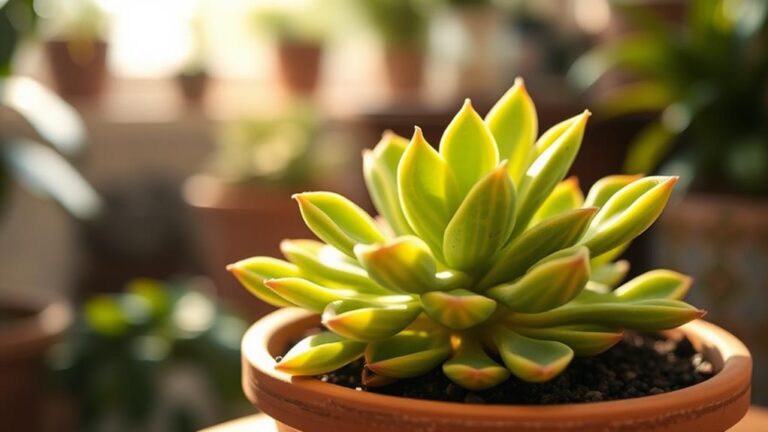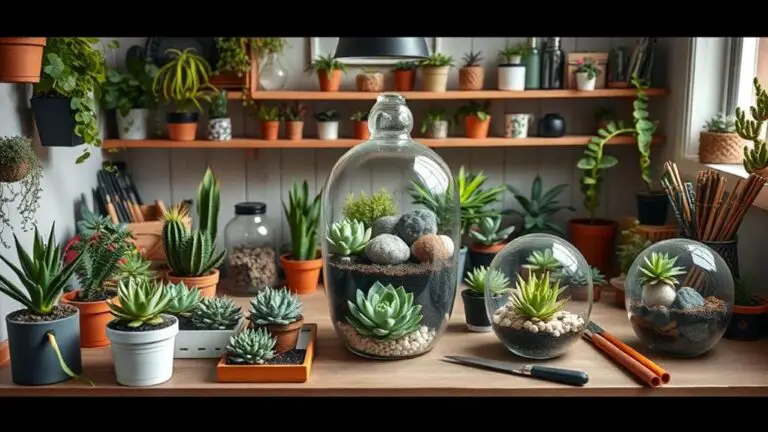Hardiness Zone Guide for Succulents in New York City California and Texas
When you're growing succulents in places like New York City, California, and Texas, understanding each area's hardiness zone is essential. New York City's colder zones (7a to 7b) mean you'll need to focus on cold-tolerant varieties such as Sempervivum and Sedum. On the other hand, California's warmer zones (8 to 9) allow for a broader range of succulents that thrive under full sun. Texas, with its diverse zones (6 to 9), requires careful selection to guarantee heat tolerance and some winter protection. So, how do you match the right succulent to your specific zone?
Understanding Hardiness Zones
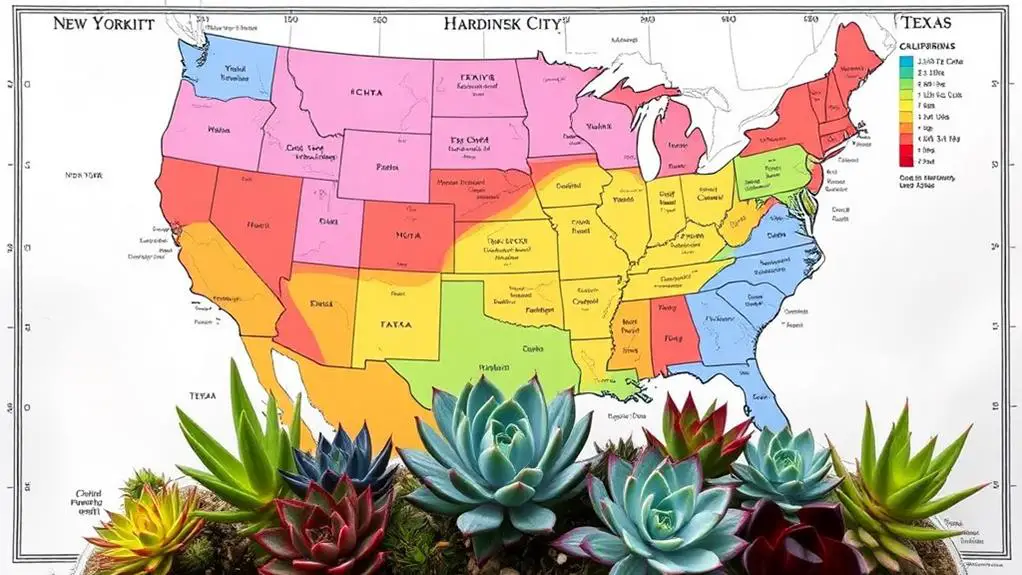
Why are plant hardiness zones important for gardening? They help you choose the right plants for your climate, guaranteeing they thrive. The USDA Plant Hardiness Zone Map is a valuable tool that divides the U.S. into 13 zones. These zones, from 1 (coldest) to 13 (warmest), are based on average minimum temperatures.
For instance, New York City falls into Zones 7a to 7b, with mild winters and moderately hot summers.
Understanding these zones is vital when growing succulents. Each zone has specific temperature ranges that indicate how well a plant can tolerate the climate. Knowing the temperature ranges helps you select a specific succulent that will flourish in your area.
For instance, if you live in New York City, you'll want to choose succulents that can handle the local climate.
Additionally, being aware of the first and last frost dates in your zone is essential. This knowledge helps you schedule planting and protect your succulents from unexpected cold snaps.
To guarantee your succulents thrive, plant them in well-drained soil. With the right preparation, you can confidently grow a variety of succulents suited to your local hardiness zone.
Succulents for New York City

When choosing succulents for New York City, you'll want varieties that can withstand the city's chilly winters and humid summers. New York City falls within USDA hardiness zones 7a to 7b, so it's important to select succulents that can handle winter temperatures as low as 0°F to 5°F (-18°C to -15°C).
Recommended succulent varieties for NYC include Sempervivum (Hens and Chicks), Sedum, and Echeveria. These plants are hardy and can tolerate the cold winters. However, outdoor succulents in NYC need winter protection. You can use frost blankets or move potted plants indoors when temperatures drop considerably. The city's humid subtropical climate also means you'll need to monitor soil moisture carefully, as succulents are prone to root rot in overly damp conditions.
Indoor cultivation is popular in NYC because it allows for controlled temperature and humidity, enabling a wider variety of succulents to thrive year-round. This makes it easier to maintain the right soil moisture levels and protect your plants from extreme weather.
| Succulent Variety | Key Characteristics |
|---|---|
| Sempervivum | Cold-hardy, forms rosettes, low maintenance |
| Sedum | Tolerant of poor soil, many varieties, colorful |
| Echeveria | Attractive rosettes, prefers well-drained soil |
| General Tips | Use winter protection, monitor soil moisture |
Succulents for California

While New York City requires hardy succulents that can brave cold winters, California offers a different set of conditions that are ideal for a diverse range of succulent species.
In California, most areas fall within hardiness zones 8 and 9, making it perfect for growing types of succulents like Aloe, Echeveria, Crassula, Kalanchoe, and Aeonium. These zones provide a warm, dry climate that often resembles desert conditions, allowing succulents to thrive year-round in many parts of the state.
To care for succulents in California, guarantee they receive full sun and are planted in well-draining soil. This is important because succulents hate soggy roots.
Monitoring temperature is key, especially in higher elevation regions where colder temperatures can harm soft succulents. These may need indoor protection during the winter months.
California's varied microclimates also play a role in how succulents grow. Coastal areas offer stable temperatures, while inland regions can experience extreme heat.
Always keep an eye on the average minimum temperature in your area. With the right care, your succulents will flourish under California's sunny skies. You've got this!
Succulents for Texas

Steering through the diverse climates of Texas, you'll find that succulents can thrive in hardiness zones 6-9 with the right care.
In Zone 6, where temperatures drop considerably, choose hardy succulent varieties like Sedum, Sempervivum, and Echeveria. These can withstand colder conditions if you protect them during freezing temperatures. Cover them or bring them inside when frost is expected to keep them safe.
In Zones 7 and above, the warmer and more arid climate is ideal for succulents such as Agave, Aloe, and Yucca. These plants thrive in the heat and can handle the Texas sun with ease. Just make certain they've well-draining soil to prevent root rot.
For indoor succulents in Texas, make sure they receive plenty of sunlight and good air circulation. This is especially important during the rainy winter months to avoid rot and promote healthy growth. Place them near windows where they can soak up the sun.
Outdoor succulents need special attention during the cooler winter months. Cover them when freezing temperatures are forecasted to protect them from frost damage.
With these tips, your succulents will flourish across the varied landscapes of Texas.
Care Tips by Zone
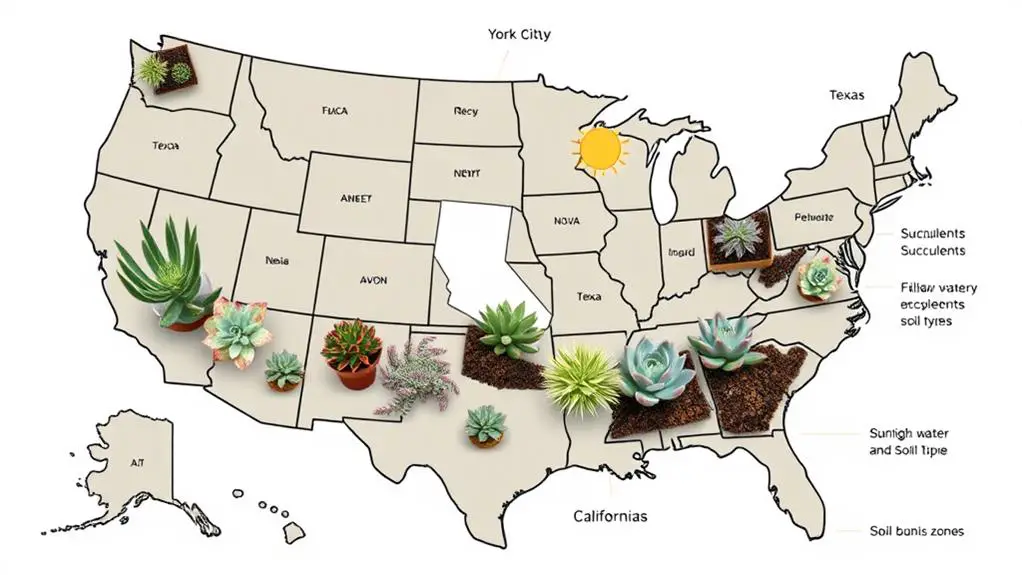
As you navigate the care of succulents in different hardiness zones, it's vital to tailor your approach to the specific climate conditions.
In New York City (Zones 4-5), succulents like Sempervivum and Sedum need winter protection from frost. They benefit from being sheltered indoors to maintain ideal temperatures and moisture levels. Monitoring sunlight is essential; place them near windows for the best light.
In California (Zones 8-9), succulents such as Aloe and Echeveria thrive in full sun exposure. You won't need much winter shelter here due to milder temperatures. However, always make sure they've well-draining soil to prevent root rot. A cactus or succulent-specific soil mix works best.
For Texas (Zones 6-9), succulents like Opuntia and Yucca need special attention during rainy winters. Shelter them indoors to avoid root rot and cover them during freezing forecasts to prevent frost damage. Regularly check sunlight exposure and adjust as needed, especially during seasonal changes.
No matter the zone, the United States Department of Agriculture suggests making certain well-draining soil and monitoring sunlight and temperature conditions.
Frequently Asked Questions
What Zone Is Texas for Succulents?
Texas spans zones 6 to 9. In zone 6, hardy succulents like Sedum thrive. Zones 7 to 9 suit Agave, Echeveria, and Aloe. Provide indoor shelter in zone 6 during winter to prevent frost damage.
Can Succulents Survive Winter in California?
Yes, succulents can survive winter in California. You should choose cold-hardy varieties like Agave or Sedum and provide frost protection for soft succulents. Guarantee proper drainage to prevent rot, especially during cold, dry winters.
Can Succulents Survive in Texas?
Yes, succulents can survive in Texas. Depending on your zone, choose varieties like Sedum and Sempervivum for colder areas, and Agave or Aloe for warmer zones. Container gardening helps you move them indoors during extreme weather.
Can Succulents Grow Outside in NY?
Yes, succulents can grow outside in NYC. Choose hardy varieties like Sempervivum and Sedum. Protect them from frost and guarantee well-draining soil to prevent root rot. South-facing locations optimize growth, and indoor cultivation helps in winter.
Conclusion
You've got this! No matter where you live—New York City, California, or Texas—you can grow beautiful succulents. Just remember to choose the right plants for your zone and give them the care they need. With a bit of planning and attention, your succulents will thrive. So, get out there and start planting! You'll enjoy watching your garden grow and change with the seasons. Happy gardening!

